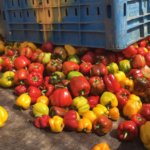Building for Palestinians in the Jordan Valley
By Silvia Boarini– February 8, 2012 – http://www.palestinemonitor.org/?p=3798
A community of about 12 families in the North of the Jordan Valley, Hadidiya was originally made up of shacks and animal shelters.
Now, amidst the depressing rubble of its previous incarnation, a handful of tents donated by international and local NGOs house the residents.
The latest demolition in Hadidiya left 12 families homeless and took place only four days after the District Coordination Office (DCO) posted the order. The lawyer hired by the community did not even have enough time to make a case against it.
The reason given by the Civil Administration was that the Bedouins are illegally settling and erecting structures on land that does not belong to them and which lies in Area C.
Laurianne, a long-time volunteer with the Jordan Valley Solidarity Campaign (JVSC) looks over the destruction and sums up Israel’s occupation policy in the area. “What they are doing is forcibly pushing all the Palestinians out of Area C into Areas A and B,” she says, “so that C remains free for settlers’ use.”
JVSC is a grassroots network of Palestinian and international volunteers who under the motto, “existence is resistance” fight forced removals in the Jordan Valley.
“We re-build Palestinian houses that have been demolished. We do it to counteract the dispersal of Jordan Valley residents as well as the growing number of settlements,” explains Laurianne.
Founded in 2003, JVSC has helped to build 120 structures, renovate 171 houses, erect 54 tents and re-build 18 demolished homes. Their work takes place almost exclusively in Area C, in villages which are under constant threat of demolition.
JVSC chooses to build without the necessary construction permits issued by the Civil Administration. They work quickly and efficiently, behind the scenes and away from the big money circulating within the international aid industry.
The chance that each of their projects may be demolished by the army or vandalized by settlers is high. If it happens, though, JSVC is there, ready to help villagers re-build. The aim is to hold on to Area C, for the long term.
A study by the Israeli organization Bimkom (Planners for Planning Rights) has shown that between 2000 and 2007 only 6% of requests for building permits filed by Palestinians residing in Area C were granted by the Civil Administration.
An impossibly low percentage for a community that needs to accommodate the very natural growth used by Israel as a justification for settlement expansion in East Jerusalem and across the West Bank.
In Al-Hadadiye, JSVC are helping re-building the tents and animal shelters demolished by the army. Hadidiya has no electricity, no water and is surrounded by flourishing settlements: Bek’ot and R’oi to the South and West, Nahal Hamdat to the East and a military base to the North.
The community has one of the lowest daily per capita consumptions of water in the West Bank. B’tselem puts it at 24L, close to levels in disaster areas such as Haiti or Sudan; well under the 100L recommended by the World Health Organization; and more worryingly about 400L below daily per capita consumption in the settlement of R’oi.
Sheep was the main source of income but lack of areas open for grazing, in a land being taken over by settlements and firing zones, has meant a sharp decrease in production of cheese and laban, traditionally the main source of income for the community.
The Benaudi clan was traditionally nomadic and has moved camp countless time in the hope of escaping the next demolition. The areas historically used by the Benaudis for settling and grazing their sheep, though, are now enclosed within settlements, firing ranges and military bases.
The only option open is to play into the hands of the occupier and move to the safe haven of Area A, where their traditional way of life will be impossible to sustain.
As an elderly Benaudi lady explains, already many of the tribe have either left to Jordan or moved to the nearby towns of Tubas or Tammoum. She will stay, though, because this is where her family has always been and where their sheep has always grazed. This is how she can resist and she is ready to stay put.
The situation here epitomizes what is happening on a larger scale in the Jordan Valley.
It exposes Israel’s long-term aim of eventually driving Palestinians out by isolating and weakening individual communities, demolishing their homes, crippling their economy and breaking their resilience.
The morale is low and a sense of hopelessness peculiar to the limbo that is Area C is in the air. Still, with the sense of ownership over the Jordan Valley firmly rooted in the wider Israeli public, Israel can portray itself as the victim not the aggressor in the conflict.
Read Silvia Boarini on Israel’s settlement of the Jordan Valley here.






